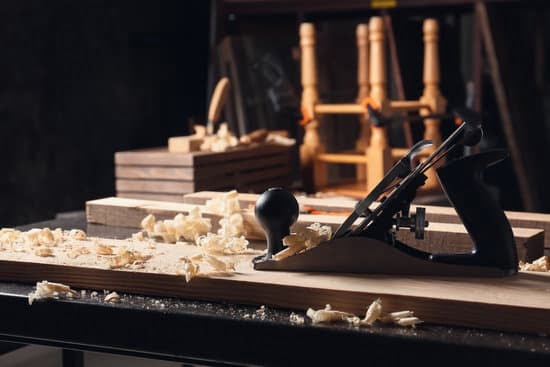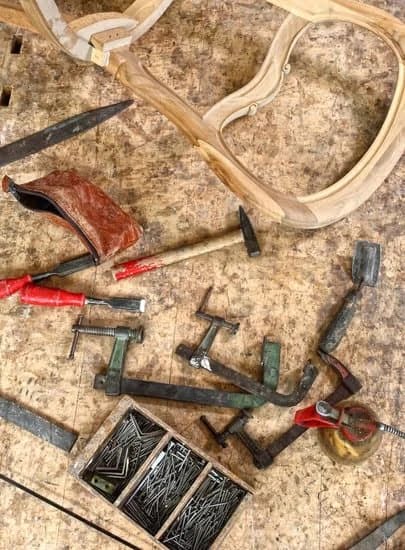Vintage hand woodworking tools hold a special charm and nostalgia that captivates both seasoned woodworkers and antique enthusiasts alike. These tools, crafted with meticulous craftsmanship from a bygone era, offer a glimpse into the rich history and artistry of woodworking. From the well-worn handles to the intricate designs on the blades, each vintage tool tells its own unique story.
When we think of woodworking today, the image of power tools may come to mind. However, there is something undeniably enchanting about using hand tools that were once the backbone of every woodworker’s craft. Vintage hand woodworking tools harken back to a simpler time when precision was achieved through skillful hands and dedicated effort.
There is an unspoken reverence for these vintage treasures in the woodworking community. Their enduring quality stands as a testament to the expertise of past artisans and serves as a reminder of the timeless beauty that can be crafted with just a few simple tools. From hand planes and chisels to saws and spoke shaves, these vintage goodies allow modern woodworkers to connect with traditions that have been passed down through generations.
In this article, we will delve into the world of vintage hand woodworking tools, exploring their history, offering tips on identification and restoration, showcasing famous woodworkers who relied on them throughout history, discussing their benefits in comparison to modern power tools, exploring where collectors can find these treasures today, and much more.
So grab your apron, put on some soothing classical music, and prepare to be transported back in time as we explore the charm and nostalgia of vintage hand woodworking tools.
The History of Vintage Hand Woodworking Tools
The history of vintage hand woodworking tools spans centuries, from ancient times to the modern revival we see today. These tools were essential for woodworkers throughout history, allowing them to create intricate pieces of craftsmanship with their hands. Understanding the evolution of these tools can help collectors and enthusiasts appreciate their value and significance.
In ancient times, woodworking tools were often made from stone or bone. As civilization advanced, metalworking techniques improved, leading to the creation of more durable and effective tools. During the Middle Ages, hand woodworking tools evolved significantly, with innovations such as the introduction of the plane and various types of saws.
The industrial revolution in the 18th century brought major changes to the world of woodworking. With advances in technology and mass production, hand woodworking tools became more accessible to craftsmen. However, as machinery took over in factories during the 19th and 20th centuries, hand tools started losing their popularity.
Fortunately, there has been a recent resurgence in interest for vintage hand woodworking tools amongst woodworkers and enthusiasts alike. The allure of using these traditional tools lies in their craftsmanship and connection to the past. Many skilled artisans appreciate the precision and control that can be achieved with these timeless instruments.
| Time Period | Key Developments |
|---|---|
| Ancient Times | Tools made from stone or bone. |
| Middle Ages | Invention of planes and various saw types. |
| Industrial Revolution | Advances in technology and mass production. |
| Modern Times | The revival of interest in vintage hand woodworking tools. |
As we delve into the history of vintage hand woodworking tools, we gain a greater appreciation for the craftsmanship and traditions that have been passed down through the ages. Whether collecting, using, or simply admiring these tools, they provide a connection to the past and offer a unique experience in today’s modern world.
How to Identify Authentic Vintage Hand Woodworking Tools
Vintage hand woodworking tools hold a special appeal for collectors and enthusiasts, as they provide a glimpse into the craftsmanship of bygone eras. However, with the increasing popularity of vintage tools, it has become crucial to be able to identify authentic pieces to ensure that you are investing in genuine items. This section will serve as a guide for collectors and enthusiasts on how to identify authentic vintage hand woodworking tools.
One of the first steps in identifying authentic vintage hand woodworking tools is examining the tool’s construction and overall design. Authentic vintage tools were often made from high-quality materials such as hardwood handles and forged steel blades. Look for signs of wear and tear that are consistent with age, as well as any unique markings or engravings that may indicate the tool’s origin or manufacturer.
Another important aspect to consider when identifying authentic vintage hand woodworking tools is the tool’s functionality. Vintage tools should be functional and able to perform their intended purpose. Examine the tool’s condition, ensuring that all parts are present and in good working order. Avoid tools that have undergone extensive repairs or modifications, as these may affect their authenticity.
Researching the history and background of various manufacturers can also aid in authenticating vintage hand woodworking tools. Many reputable manufacturers have distinct hallmarks or branding on their products, which can help determine authenticity. Online resources, antique tool reference books, and knowledgeable experts in the field can provide valuable information on different manufacturers and their respective marks.
Furthermore, it is essential to be mindful of reproductions or modern imitations masquerading as vintage hand woodworking tools. Educate yourself about common signs of reproductions, such as perfect finishes or excessive pristine conditions that seem inconsistent with age.
By following these guidelines for identifying authentic vintage hand woodworking tools, collectors and enthusiasts can make informed purchasing decisions and build a collection that reflects true historical significance.
| Key Factors | Identifying Authentic Vintage Hand Woodworking Tools |
|---|---|
| Construction and Design | Look for high-quality materials, signs of wear and tear consistent with age, and unique markings or engravings. |
| Functionality | Ensure that the tool is in good working order and has not undergone extensive repairs or modifications. |
| Manufacturer’s Hallmarks | Research different manufacturers and their distinct marks to determine authenticity. |
| Beware of Reproductions | Familiarize yourself with signs of reproductions, such as perfect finishes or an excessively pristine condition. |
Unveiling the Hidden Gems
Vintage Hand Plane
One of the most essential vintage hand woodworking tools that every woodworker should have in their collection is a vintage hand plane. These planes were traditionally used for shaping and smoothing wood surfaces, and they continue to be favored by woodworkers for their versatility and precision.
When searching for a vintage hand plane, look for one with a solid body made from high-quality materials such as rosewood or beech, along with a properly flattened sole. Additionally, consider factors such as the condition of the blade and its adjustability.
Antique Chisels
Antique chisels are another set of hidden gems that every woodworker should consider adding to their toolbox. These chisels are known for their exceptional build quality and durability, making them ideal for various woodworking tasks such as carving, shaping, and creating joinery. Look for antique chisels that have a sharp cutting edge with no chips or cracks in the blade, and handles that are intact and comfortable to grip.
Hand Brace
A vintage hand brace is an indispensable tool for drilling holes accurately and efficiently in woodworking projects. Unlike modern electric drills, hand braces offer greater control and precision while retaining the charm of traditional craftsmanship. When selecting a vintage hand brace, ensure that it has smooth gears without any rust or damage, as well as a sturdy chuck to securely hold different size bits.
Wooden Mallet
A wooden mallet is an often overlooked but important tool in the arsenal of every woodworker. Traditionally made from hardwoods such as beech or lignum vitae, these mallets are used to strike chisels or other tools without causing damage to delicate surfaces. Look for a vintage wooden mallet with a solid head free from cracks or splits, paired with a comfortable handle that allows for a strong grip.
Carpentry Marking and Measuring Tools
Lastly, no woodworking toolbox is complete without a set of vintage carpentry marking and measuring tools. This includes items such as vintage marking gauges, sliding bevels, try squares, and folding rules. These tools play a crucial role in ensuring accurate measurements and precise markings during various woodworking tasks. When hunting for these vintage tools, look for ones that are still in good working condition with clear and legible markings, as well as straight edges for accuracy.
These top 5 must-have vintage hand woodworking tools serve as the foundation for any woodworker’s collection. Investing in these hidden gems not only adds a touch of nostalgia to your workshop but also allows you to embrace the craftsmanship of yesteryear while benefiting from their timeless functionality and beauty.
Restoring and Maintaining Vintage Hand Woodworking Tools
Restoring and maintaining vintage hand woodworking tools is not only essential for their longevity but also for preserving their timeless beauty. These tools hold a rich history and are often considered valuable collectibles. To ensure their functionality and aesthetic appeal, it is crucial to follow proper restoration and maintenance techniques. Here are some tips and tricks for enthusiasts and collectors:
- Cleaning: The first step in restoring vintage hand woodworking tools is cleaning off dirt, rust, and grime that may have accumulated over the years. Use a soft cloth or brush to remove loose particles from the surface. For stubborn rust, consider using a rust remover solution or WD-Be cautious when using these chemicals to avoid damage to the tool’s original finish.
- Removing Paint: In some cases, vintage tools may have been painted over in the past. To uncover their original beauty, gently strip away any layers of paint using a paint stripper or heat gun. Take care not to apply excessive heat or force as it can damage the tool’s wooden components.
- Sharpening: Sharpening blades is crucial for optimal performance while working with vintage hand woodworking tools. Invest in quality sharpening stones or honing guides specifically designed for different types of blades like chisels, planes, and saws. Follow proper sharpening techniques such as maintaining consistent angles and honing until you achieve a fine edge.
- Lubrication: To prevent rusting and ensure smooth operation, regularly lubricate your vintage hand woodworking tools with appropriate lubricants like oil or wax. Apply a thin layer on moving parts such as hinges, joints, or threads using a cloth or brush.
- Storage: Proper storage plays a key role in maintaining the pristine condition of vintage hand woodworking tools. Store them in a clean, dry environment away from moisture and extreme temperatures that can cause damage over time. Using protective covers or cases can further safeguard them from dust and scratches when not in use.
These tips and tricks for restoring and maintaining vintage hand woodworking tools will help you preserve their timeless beauty while also ensuring their functionality for years to come. By taking care of these unique pieces of craftsmanship, you can continue to appreciate their charm and relish the experience of working with tools that have stood the test of time.
The Benefits of Using Vintage Hand Woodworking Tools
Vintage hand woodworking tools offer a range of benefits that make them appealing to both experienced woodworkers and beginners alike. While modern power tools have undoubtedly revolutionized the field of woodworking, the traditional craftsmanship and charm of vintage hand tools continue to hold a special place in many woodworker’s hearts. This section explores the unique advantages that using vintage hand woodworking tools can bring to your woodworking projects.
One of the main benefits of using vintage hand woodworking tools is the unparalleled sense of connection and control they provide. Unlike power tools, which often require less physical effort, vintage hand tools require the woodworker to rely on their own strength and technique.
This hands-on approach allows for a deeper understanding and appreciation of the wood itself, as well as greater precision in shaping and smoothing surfaces. The tactile feedback from these traditional tools fosters a more intimate relationship with the material being worked upon, resulting in a more personal and satisfying woodworking experience.
In addition to the intimate connection they provide, vintage hand woodworking tools are also known for their durability and longevity. Many of these tools were crafted with high-quality materials such as hardwood handles and tempered steel blades, ensuring their longevity despite years or even decades of use. With proper care and maintenance, these vintage tools can last for generations, making them an investment that can be passed down through families or shared among fellow woodworkers.
Furthermore, vintage hand woodworking tools offer flexibility and versatility that can be hard to find with modern power tools. These traditional implements are designed to perform multiple tasks, allowing woodworkers to accomplish a wide variety of projects with just a few essential pieces.
From carving intricate details to shaping rough lumber, vintage hand woodworking tools can handle numerous tasks effortlessly. Their simplicity also means that they often do not require electricity or batteries, making them portable options for working in remote locations or during power outages.
Showcasing Masterpieces
Throughout history, there have been countless woodworkers who have left their mark on the craft with their exceptional skills and masterpieces. These highly skilled artisans were known for their attention to detail and craftsmanship, often relying on vintage hand woodworking tools to create their works of art. In this section, we will explore some famous woodworkers throughout history and discover the preferred vintage hand tools that they used to bring their visions to life.
One such legendary woodworker is Sam Maloof, renowned for his innovative designs and ability to create furniture that seamlessly blended form and function. Maloof was a firm believer in using traditional hand tools alongside power tools to achieve the best results. His preferred vintage hand tool was the block plane, which he used extensively in shaping the curves and contours of his furniture pieces.
Another notable woodworker is James Krenov, celebrated for his minimalist approach to woodworking and impeccable craftsmanship. Krenov believed in working slowly and intentionally, using only a few select hand tools to bring out the natural beauty of wood. His go-to vintage hand tool was the scraper plane, which he used for final smoothing and finish work.
In addition to these modern-day masters, it is impossible not to mention renowned figures from history such as Thomas Chippendale, Gustav Stickley, and George Nakashima. These influential woodworkers each had their own preferred vintage hand tools that they relied on to craft their iconic pieces.
Chippendale favored using antique woodworking planes with intricate detailing for carving ornate features into his furniture creations. Stickley, a prominent figure in the American Arts and Crafts movement, emphasized sturdy construction techniques and relied heavily on vintage saws for precision cutting. Nakashima was known for his organic designs that showcased the natural beauty of wood grains. He cherished vintage chisels as they allowed him meticulous control over intricate joinery work.
By exploring the preferred vintage hand tools of famous woodworkers throughout history, one can gain a greater appreciation for the craftsmanship and attention to detail that goes into creating timeless masterpieces. These woodworkers serve as inspiration for contemporary artisans, reminding us of the importance of using quality tools that have stood the test of time.
Inspiring Creativity
Vintage hand woodworking tools not only have historical significance and aesthetic beauty, but they also inspire creativity in the hands of woodworkers. Craftsmen who choose to work with these vintage tools often find that their unique features and craftsmanship bring out new levels of creativity and artistic expression. This section will explore how vintage hand woodworking tools can ignite the imagination and help craftsmen create unique pieces.
Connecting with Tradition
Working with vintage hand woodworking tools allows craftsmen to connect with the traditions and techniques of the past. The history behind each tool adds depth and meaning to the creative process. As woodworkers use these tools, they become part of a lineage of skilled artisans who worked tirelessly to perfect their craft. This connection to tradition can instill a sense of pride and purpose in craftsmen as they create their own unique pieces.
Embracing Limitations
Vintage hand woodworking tools often have limitations compared to modern power tools, such as slower execution or limited functionality. However, these limitations can actually inspire creativity by encouraging woodworkers to think differently and problem-solve when faced with challenges.
For example, a lack of interchangeable blades may prompt a craftsman to use alternative methods or modify existing blades, resulting in innovative approaches and distinct designs. Embracing the limitations of vintage tools forces woodworkers to rely on their skills and ingenuity, ultimately leading to truly one-of-a-kind creations.
Preserving Artistry
Vintage hand woodworking tools possess a level of artistry that is often lacking in mass-produced modern tools. These older tools were crafted by master craftsmen who paid attention to every detail; from elaborate handles carved from exotic woods to finely-tuned blades made from high-quality steel. Working with such beautifully crafted tools not only enhances the woodworker’s experience but also imbues their creations with an added sense of artistry and craftsmanship.
Where to Find Vintage Hand Woodworking Tools
Vintage hand woodworking tools are highly sought after by collectors and enthusiasts alike. The unique craftsmanship and timeless beauty of these tools make them not only functional but also pieces of art. Whether you are a seasoned woodworker or just starting out, finding the right vintage hand woodworking tools can enhance your projects and add a touch of nostalgia to your workshop. In this section, we will explore where to find these treasures – both online platforms and local markets.
Online Platforms
- eBay: eBay is a popular online marketplace where you can find a wide range of vintage hand woodworking tools. It offers a vast selection from various sellers, giving you the opportunity to compare prices and conditions before making a purchase.
- Etsy: Etsy is known for its handmade and vintage items, making it an excellent platform for finding unique vintage hand woodworking tools. Many sellers on Etsy specialize in restoring and selling antique tools, ensuring their authenticity and quality.
- Online Auctions: Online auctions such as LiveAuctioneers or Heritage Auctions are treasure troves for finding rare and collectible vintage hand woodworking tools. These platforms allow you to bid on items directly or participate in live auctions where you can potentially acquire one-of-a-kind pieces.
Local Markets
- Flea Markets: Visiting flea markets in your area can be an exciting adventure, as you never know what hidden gems you might discover. Many vendors at flea markets offer antique and vintage items, including hand woodworking tools. Take your time exploring different stalls to find unique pieces at reasonable prices.
- Antique Stores: Local antique stores are often a haven for vintage tool enthusiasts. These stores specialize in selling antiques ranging from furniture to old tools. Paying a visit to these establishments allows you to personally examine the condition of the tools before purchasing.
- Woodworking Clubs or Associations: Joining local woodworking clubs or associations can be an excellent way to connect with fellow enthusiasts and gain access to a network of individuals who may be willing to sell or trade vintage hand woodworking tools. These communities often have members who are passionate about preserving the heritage of these tools and can provide valuable insights on where to find them.
By exploring both online platforms and local markets, you can increase your chances of finding the perfect vintage hand woodworking tools for your collection or workshop. Whether you prefer the convenience of online shopping or enjoy the thrill of hunting down treasures in person, both options offer unique opportunities to embrace the rich history and legacy of these remarkable tools.
Conclusion
In conclusion, vintage hand woodworking tools are not just simple tools; they carry with them a sense of charm, nostalgia, and history. From ancient times to the modern revival, these tools have evolved and have become beloved by collectors and enthusiasts. By learning how to identify authentic vintage hand woodworking tools and restoring them to their former glory, we can preserve their timeless beauty for future generations.
For every woodworker, there are top must-have vintage hand woodworking tools that can make a significant difference in their craft. These hidden gems are often sought after by those who appreciate the quality craftsmanship of the past. Restoring and maintaining these tools is crucial for their longevity and optimal performance. By following tips and tricks for preservation, we can ensure that these tools remain in use for years to come.
Using vintage hand woodworking tools offers numerous benefits. They provide a connection to tradition and craftsmanship that cannot be replicated by modern technology. The simplicity of these tools allows woodworkers to focus on the artistry of their craft, promoting creativity and inspiring unique creations. Famous woodworkers throughout history have recognized the value of vintage hand tools and have used them to create timeless masterpieces.
For those interested in starting or expanding their collection of vintage hand woodworking tools, there are various online platforms and local markets available. The satisfaction of finding a rare tool or discovering a new gem among others who share your passion cannot be overstated.
In embracing the past and preserving the legacy of vintage hand woodworking tools, we pay tribute to the skillful artisans who came before us. These timeless artifacts connect us to our roots as woodworkers while also allowing us to push boundaries and explore our own creativity.
Whether you are a collector or an enthusiast looking to dive into this world, vintage hand woodworking tools offer an unparalleled journey through time while enabling us to create something truly special with our own hands.

Hi everyone! I’m a woodworker and blogger, and this is my woodworking blog. In my blog, I share tips and tricks for woodworkers of all skill levels, as well as project ideas that you can try yourself.





